Connecteam offers an all-in-one, mobile-first solution built for deskless teams, with strong time tracking and scheduling tools. ClickUp excels in project and task management, with some time tracking but limited scheduling features.
Choosing between Connecteam and ClickUp? While both platforms help teams stay organized and track work, they’re built for different kinds of workflows and teams.
Connecteam is an all-in-one solution with various features designed for managing deskless, frontline, and field teams. ClickUp is a flexible project and task management platform that’s more popular with desk-based, tech-savvy teams.
Below, I break down how each platform fits different business models, daily tasks, and real-world goals (like team management, scheduling, project oversight, and compliance) to help you decide which tool best supports your team’s workflow.
A note about our method: All product comparisons and verdicts in this guide are based on hands-on testing by our expert team. Every screenshot was taken from real use during our evaluation.
At a Glance: Quick Summary
Connecteam is best known for its all-in-one mobile-first solution covering time tracking, shift scheduling, task management, and internal communication. It’s ideal for deskless and frontline teams that need to track work hours, manage shifts, and handle daily operations from one place. While it has features for project management, it’s missing more advanced features, like Gantt charts.
ClickUp, on the other hand, is primarily a project and task management platform that also includes built-in time tracking and task scheduling features. While it’s great for planning, distributing work, and building reporting dashboards for office-based teams, its time tracking feels clunky at times.
Pricing and Plans
Take a look at the different pricing and plans available with both Connecteam and ClickUp:
| Plan Type | Connecteam | ClickUp |
| Free Plan | Small Business Up to 10 users Access to all features and hubs. | Free Unlimited users Includes: 60MB storage Unlimited tasks Two-factor authentication Collaborative docs Kanban boards Sprint management Calendar view Custom field manager basic In-app video recording 24/7 support 1 form |
| Starter | Basic $29/month for up to 30 users (+$0.50 for each additional user) Includes: Clock in & out with GPS Unlimited jobs Payroll integration Basic scheduling Unlimited checklists, forms, and tasks | Unlimited $7/user/month Includes: 2GB storage per user Unlimited folders and spaces Integrations Guests with permissions 3 teams (user group) Native time tracking Goals & portfolios Resource management AI compatibility And unlimited: Gantt charts Custom fields Chat messagesForms |
| Pro/Premium | Advanced $49/month for up to 30 users (+$1.50 for each additional user) Includes everything in Basic, plus: Time clock customization Auto clock-out 10 Geofence sites Advanced filters and bulk actions Ability to schedule recurring shifts Scheduling templates Shareable live link of your schedule Conditional fields in forms | Business $12/user/month Includes everything in the Unlimited, plus: Sprint points & reporting Automation integrations Custom exporting Private whiteboards Workload management SMS 2-Factor Authentication More automations And unlimited: StorageTeams Message history Mind maps Activity & timeline views Dashboards & whiteboards |
| Expert $99/month for up to 30 users (+$3 for each additional user) Includes everything in Advanced, plus: Shift auto-assignment 12 different schedules Shift shortcuts Time clock and forms auto-reports API access And unlimited: Sub-jobs Shift attachments Geofence sites Shift-tasks | ||
| Enterprise | Custom pricing Includes everything on the Expert plan, plus: Unlimited time clocks and schedules Auto-reports and shareable schedule links Advanced security (SSO, 2FA, biometric lock) Personal success manager Higher API limits & webhook management | Custom pricing Includes everything in Business, plus: White labeling Conditional logic in forms Team sharing for Spaces Custom roles Custom capacity in workload Enterprise API Unlimited posts Default personal views Advanced permissions Advanced public sharing MSA & HIPAA available Single sign-on SCIM provisioning US, EU, & APAC data residency Live onboarding training Customer success manager Access to managed services |
| * All prices show the monthly cost when billed annually as of September 2025. | ||
I like how Connecteam’s pricing keeps things straightforward for growing teams. Its free plan covers up to 10 users, while its higher plans cost a flat rate for up to 30 users, plus reasonable per-user fees for each additional user beyond that.
If you have 50 employees, the Basic plan would cost about $39/month, whereas the Advanced plan would be $79/month.
Please note that Connecteam has 3 hubs with separate features: Operations, Communications, and HR & Skills. All hubs have the same tiers and prices but are charged separately. The features in the table above are from the Operations hub.
ClickUp charges per user for every user, which adds up quickly as your team grows. A 50-user team would pay $350/month on the Unlimited plan or $600/month on Business—much higher than Connecteam.
I find Connecteam offers better value for businesses with many hourly or field employees that need reliable time tracking and scheduling.
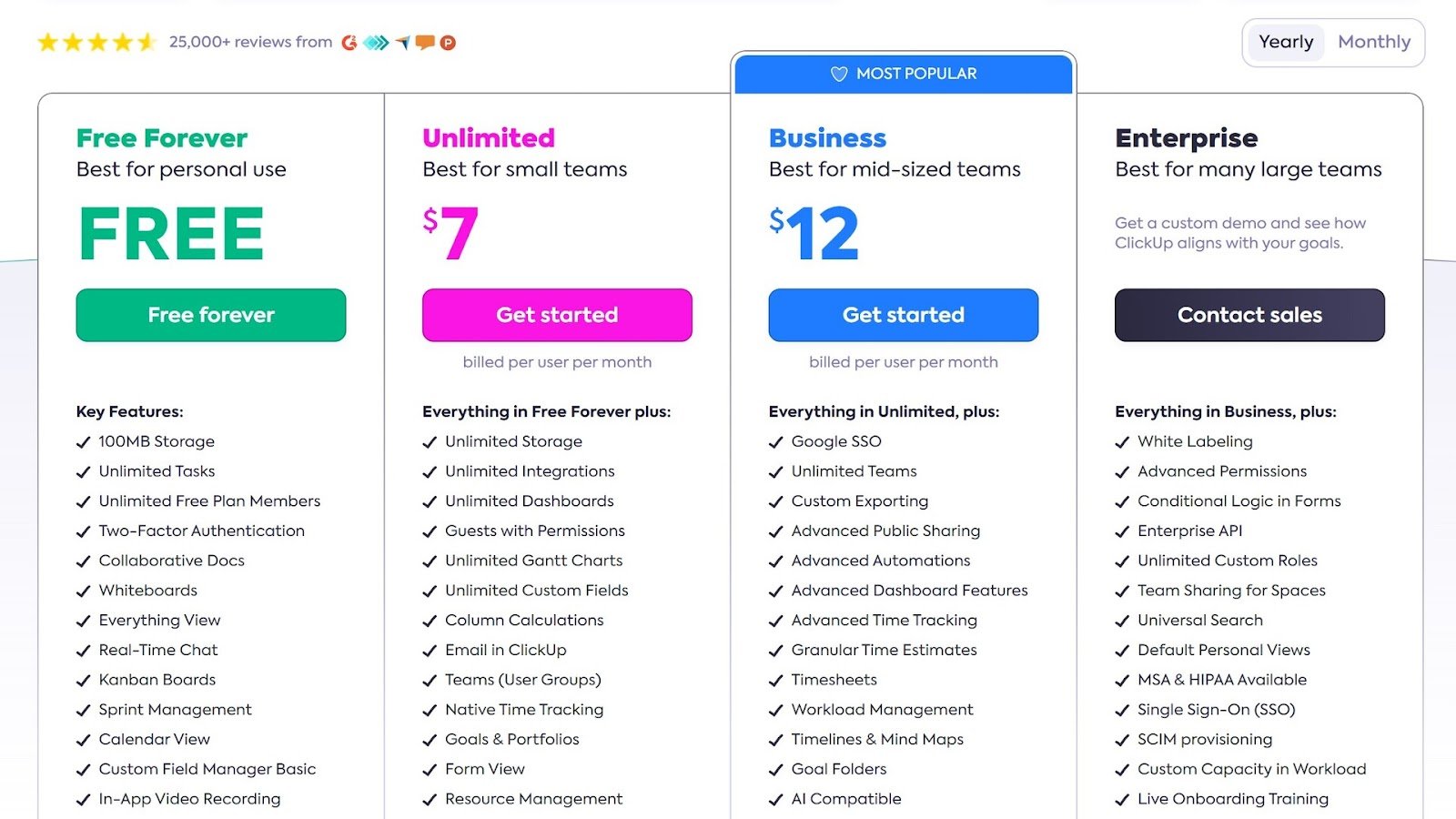
Pros and Cons
Connecteam pros ✅
- It has a mobile-first design with comprehensive time tracking, scheduling, and communication tools tailored for frontline and field teams.
- It offers affordable fixed pricing for up to 30 users, making it cost-effective for growing teams.
Connecteam cons ❌
- Some advanced features require higher-tier plans.
- There are limited advanced project management tools compared with dedicated platforms.
ClickUp pros ✅
- Customizable reporting dashboards provide useful insights.
- It offers strong Gantt charts, dependencies, and goal tracking.
ClickUp cons ❌
- The complex user interface can be overwhelming.
- Time tracking is finicky and unintuitive.
Use Cases
Connecteam is best for:
- Accurate time tracking with GPS verification: It’s ideal for mobile and field teams needing precise, real-time clock-ins across multiple sites.
- Shift scheduling and team communication: Easy schedule creation, sharing, and updates with templates, live links, and notifications (plus in-app messaging) keep teams aligned.
ClickUp is best for:
- Work distribution and workload visibility: Its tools make it easy to assign tasks and monitor deadlines across teams.
- Customizable reporting dashboards: These provide insights into team performance and time estimates to support planning.
Side-by-Side Feature Overview
When exploring Connecteam and ClickUp, I noticed big differences in how they handle scheduling, mobile functionality, PTO, and reporting. Here’s how they stack up across different categories.
Time tracking and scheduling — Winner: Connecteam
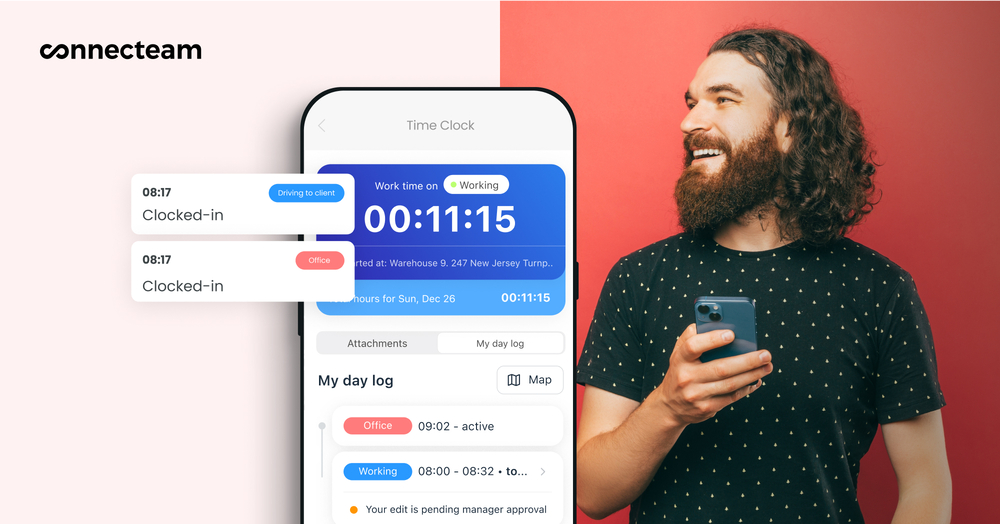
Connecteam supports time tracking primarily through its employee time clock on its mobile app. Employees can clock in and out with 1 tap, and GPS features help managers verify where hours are logged. Setup is intuitive, and automated clock-out and overtime alerts help reduce time theft. Workers can also track time against specific jobs, clients, and even projects (alongside sub-jobs, sub-projects, etc.), plus mark time as billable or nonbillable, so I think the timer works well for project-based tracking, too.
Your workers can manually edit their time entries, and you can use admin controls, like locking approved timesheet days to prevent edits, to maintain control.
The scheduling features are also great: I really like the drag-and-drop employee scheduler with shift templates and shift-swapping functionality. These make managing frontline schedules straightforward. There’s even an auto-scheduler that automatically assigns shifts based on availability, qualifications, and more.
ClickUp positions itself as an all-in-one work platform with built-in time tracking and scheduling.
With it, employees track time against specific tasks. Unfortunately, we found starting the timer required several clicks and task setup steps, making it less seamless than Connecteam. The small timer modal was also easy to miss, which could lead to accidental overreporting. That said, we appreciated that employees can manually edit entries on their timesheets and view totals by task and day.
I think ClickUp works well for project-based tracking, but without GPS features, it’s less suited to teams needing location-based enforcement.
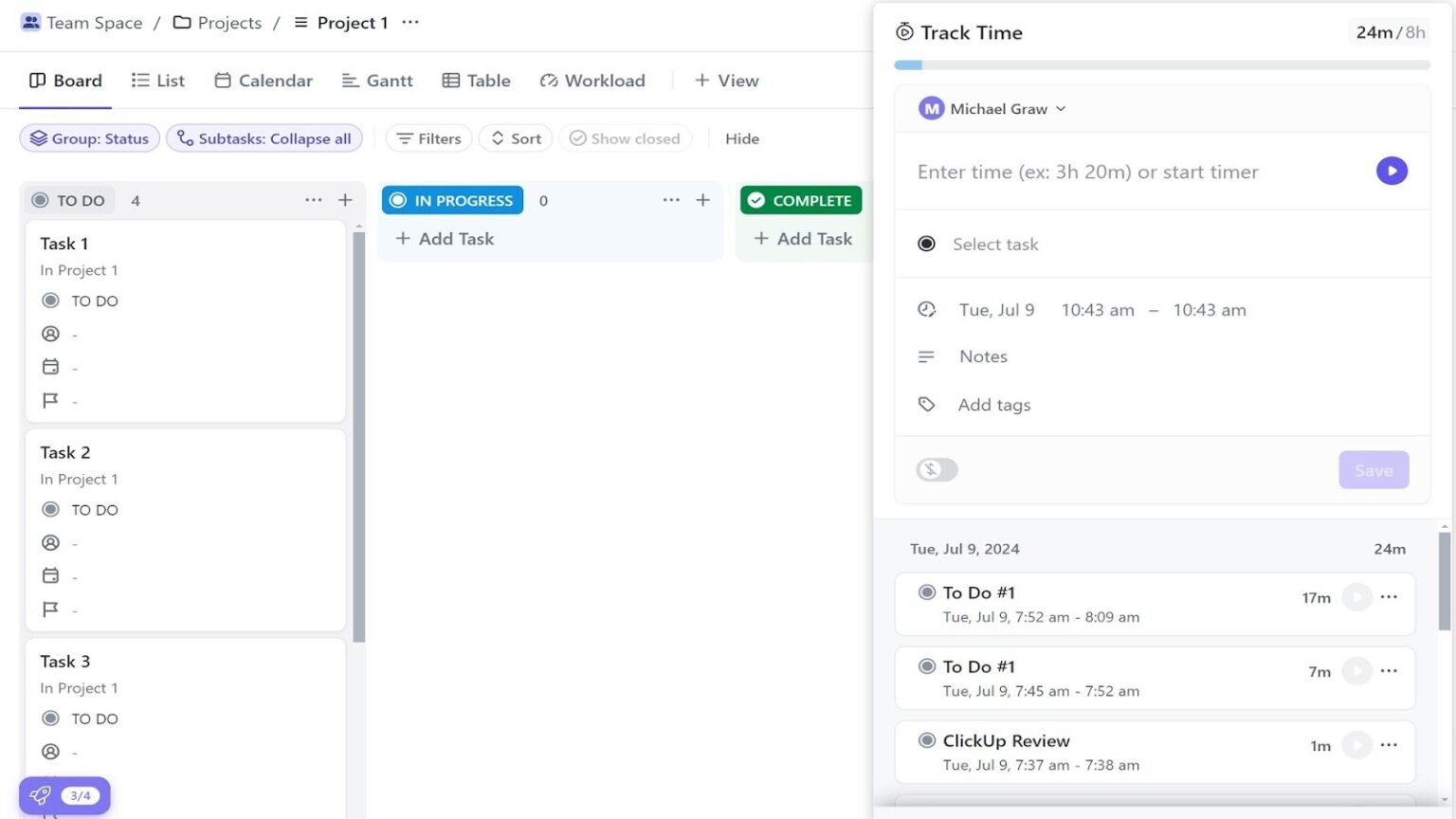
When we tested ClickUp, we found that its “scheduling” features are really task scheduling tools rather than true shift scheduling. However, you can assign tasks with dates, times, and time estimates, which helps plan workloads and compare actual time spent against what was originally budgeted.
We also liked the workload view, which shows each employee’s daily capacity alongside unassigned tasks, and the goals feature that tracks progress toward specific targets.
Despite these positives, ClickUp lacks core scheduling features like shift templates, conflict alerts, or live shift swapping—so it falls short if you actually need to manage employee shifts.
Real Scheduling. Real Time Tracking.
Shift planning and clock-ins built for real teams, not just task lists.
Team management & communication – Winner: Tie
Connecteam’s communication hub is built with workforce-wide communication in mind. I like how easy it is to share updates through a social media-style feed, send messages 1:1 or to groups via the online team chat, and even schedule communications to come through only during work hours.
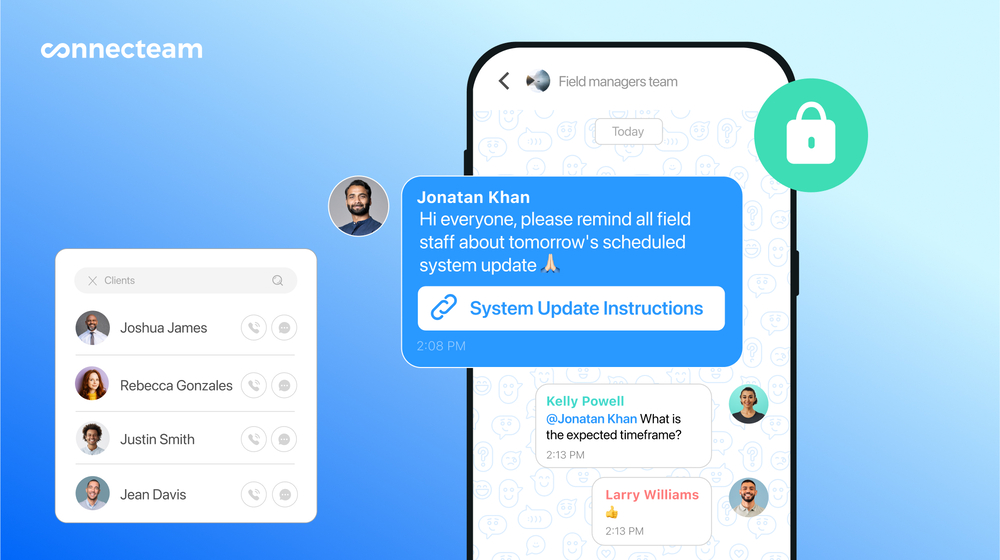
The built-in directory can help you quickly find the right contacts. I also like how tools like surveys and the internal ticketing system make it simple to gather feedback and resolve internal issues efficiently. Everything feels geared toward keeping communication clear, structured, and accessible, especially for teams in the field.
ClickUp offers a more project-focused communication experience. I appreciate features like task comments, real-time chat, and collaborative whiteboards to brainstorm and coordinate work. Being able to send and receive emails directly within the platform is a big plus, especially when managing tasks tied to external communication.
While both platforms support strong communication, I found Connecteam more effective for broad team engagement, while ClickUp seems better suited for detailed collaboration within project workflows.
Project and task oversight – Winner: ClickUp
I really appreciate how ClickUp offers a powerful all-in-one project management platform that brings projects, docs, and chat together—plus AI features that help automate workflows and cut down on busywork. With over 15 customizable views like List, Gantt, and Calendar, I found it adapts well to complex projects, letting teams manage tasks, dependencies, and deadlines smoothly. The centralized docs that link project plans and requirements directly to tasks are a big plus, and automated reporting keeps everyone accountable and on track.
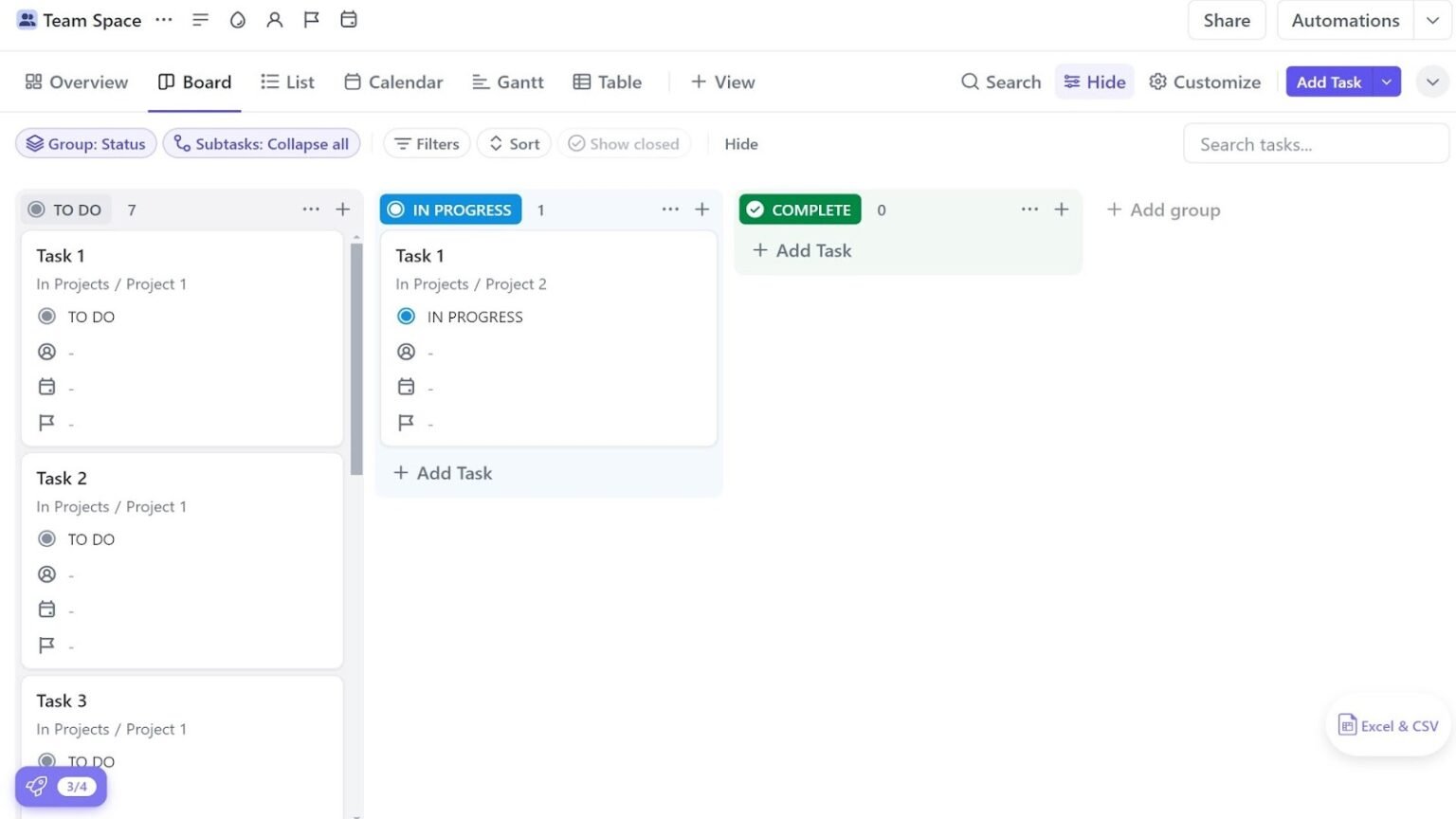
On the other hand, Connecteam focuses on straightforward task management that works well for frontline and deskless teams. I like how easy it is to create tasks with detailed descriptions, subtasks, attachments, and start and due dates, all while staying connected with real-time push notifications and in-task chat. It’s clearly designed to keep operational teams organized without overwhelming them with complexity.
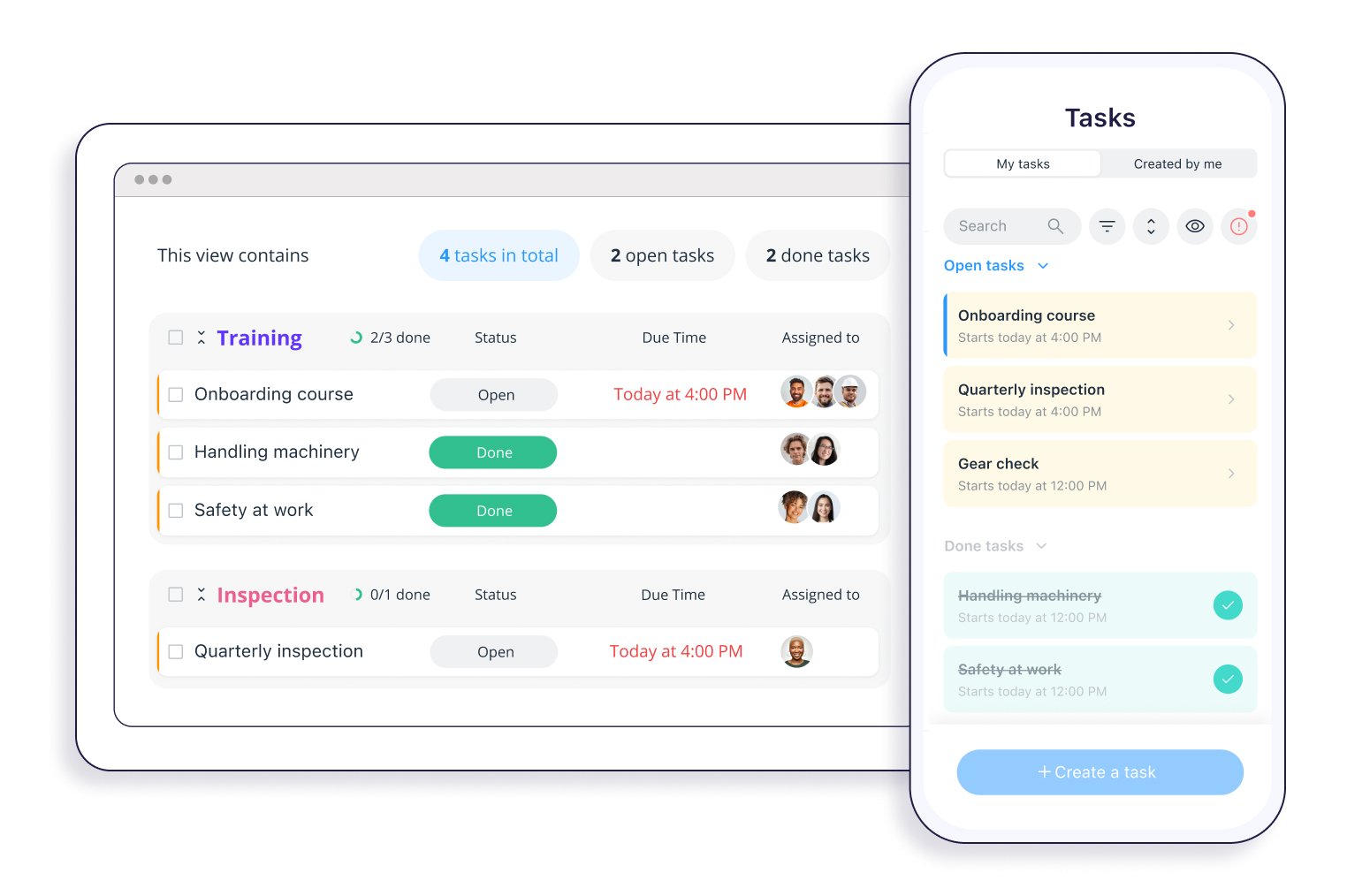
While Connecteam is great for managing day-to-day tasks in the field, I found ClickUp’s advanced customization, AI-powered tools, and overall project oversight make it a stronger fit for teams juggling complex workflows and projects that need tight coordination.
Reporting and timesheet approvals — Winner: Connecteam
Connecteam’s centralized timesheets make it easy to review daily hours for all employees without hassle, so managers can monitor billable work and approve hours before payroll. I also like how reporting tools are focused and intuitive, offering customizable dashboards that help managers track workforce productivity without getting overwhelmed. You can choose which data points to display (like total hours, absences, or break time) and export filtered reports as PDF or Excel files for audits, client billing, or internal reviews.
ClickUp’s reporting features are powerful but scattered across the platform, which gave us mixed feelings when we tested it. On the plus side, you can access timesheets within the time tracking module and use a centralized reporting area with pre-made or custom dashboards. We liked the task-focused reports and workload graphs, which help identify over- or under-scheduling. However, the time reports, which let you sort all workers’ time entries using different filters, lacked visual appeal and felt redundant alongside timesheets.
We found that building dashboards took time but offered valuable insights once set up. The platform supports exporting reports to PDF or Excel, adding flexibility.
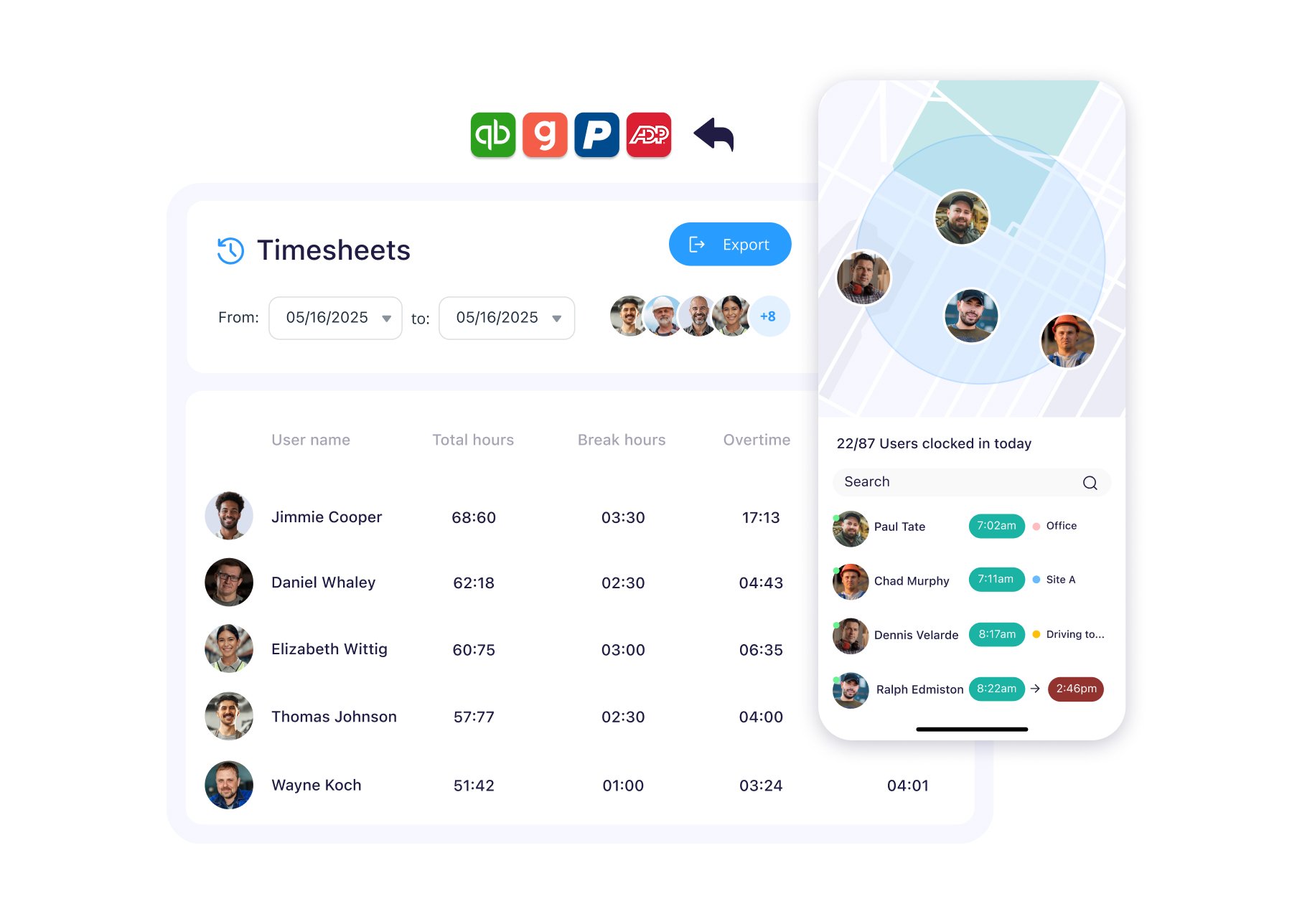
Compliance and operations — Winner: Connecteam
Connecteam offers comprehensive compliance features designed to help managers enforce break rules and control overtime. Managers can set rules based on shift length to restrict early or late clock-ins, receive alerts for missed punches, and customize overtime limits by day or week. The system even prevents clock-ins that would cause unauthorized overtime and can clock out users who go into unapproved overtime.
I find it especially useful that these compliance rules are visible in the scheduler, helping catch issues before they happen. Automatic break deduction adjusts timesheets if employees forget to clock out for breaks, reducing payroll errors and ensuring compliance with break laws. Additionally, detailed audit logs track who edits timesheets and why, and managers can collect digital signatures for stronger documentation.
ClickUp includes features aimed at supporting compliance, such as tools for tracking work hours, breaks, overtime, leave, and maintaining audit trails. But it doesn’t include the level of automation Connecteam does—for instance, it can’t automatically clock out workers entering unapproved overtime or automate breaks.
Automate Your Everyday Operations
Enforce breaks, control overtime, and stay compliant with Connecteam.
Integrations — Winner: Tie
Connecteam integrates with popular payroll and accounting platforms like QuickBooks, Gusto, and ADP, allowing seamless export of timesheet data. Its API access and webhook management further enable automation tailored to business processes. I think these integrations can simplify payroll workflows and reduce manual data entry, which is especially useful for businesses with weekly or biweekly payroll runs.
It integrates with some other software, too, including Zapier, Lightspeed POS, and Wix.
ClickUp supports over 1,000 integrations, including time tracking apps like Toggl, Harvest, and Everhour, which we found preferable to its built-in time tracking. It also connects easily with tools like Slack, Google Drive, and Outlook, letting office-based teams manage communication, document sharing, and calendar syncing in one place.
However, ClickUp lacks native payroll or invoicing integrations, requiring users to manually export timesheets and upload them to other systems. While Enterprise customers can use ClickUp’s API to automate this process, we’d prefer to see more built-in integrations with key payroll and accounting tools to simplify operations—especially for teams that rely on automated payroll processing and compliance reporting.
Ultimately, the winner depends on your needs: ClickUp wins if you need a wider variety of integrations, while Connecteam wins if you need payroll integrations.
Mobile experience and accessibility — Winner: Connecteam
I like how Connecteam’s mobile app is purpose-built for frontline and field teams. It’s designed to be intuitive: Employees can clock in with 1 tap, view or swap shifts, submit PTO requests, and chat with managers and coworkers all in one place.
I appreciate how the app’s clean design and straightforward navigation make it easy for employees to stay on top of their schedules and tasks without getting bogged down in complicated menus. Push notifications and real-time updates keep everyone in the loop, reducing scheduling conflicts and making shift changes less of a hassle.
ClickUp’s mobile app mirrors the web platform and includes nearly all the same task views and tools. While I like that everything is available on mobile, during testing, we found the app complex and menu-heavy. For instance, starting a timer took several taps, which didn’t feel practical for quick use in the field.
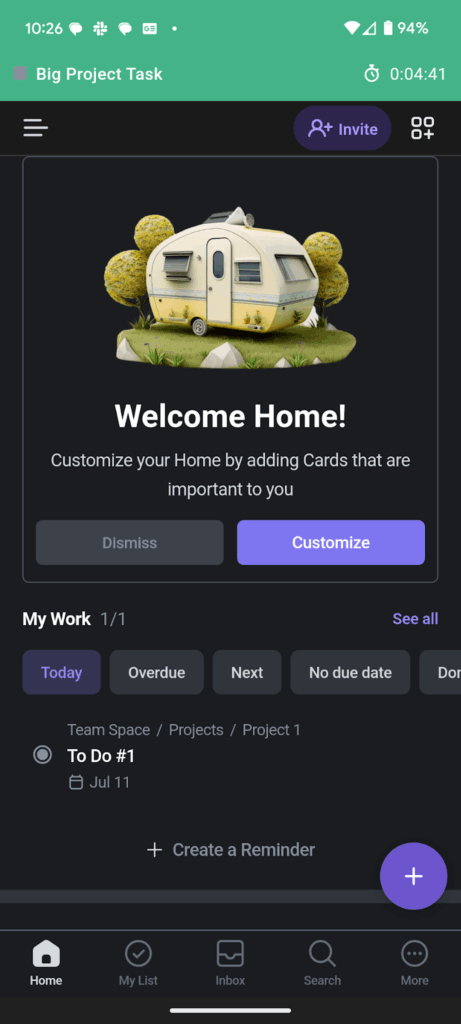
The App That Works Wherever Your Team Does
Connecteam keeps your team connected from anywhere.
User Ratings
Both Connecteam and ClickUp receive strong ratings on major review platforms. However, Connecteam’s scores are based on a larger user base, which I think adds credibility to its reputation for ease of use, mobile functionality, and dependable performance.
Connecteam
ClickUp
Security & Compliance
| Category | Connecteam | ClickUp |
| Data Encryption | ✅ Data encrypted in transit with HTTPS | ✅256-bit SSL encryption |
| GDPR Compliant | ✅ | ✅ |
| Hosting Region | US, Australia, Israel, European Economic Area (EEA) | US and EU |
| Admin Controls | ✅ Role-based access, detailed with audit logs | ✅Role-based access, user permissions |
| 2FA Available | ✅ | ✅ |
| Certifications (SOC 2, ISO, HIPAA) | ✅SOC 2, ISO 27001, HIPAA | ✅SOC 2 and ISO 27001. HIPAA for Enterprise customers only. |
Both Connecteam and ClickUp provide strong security measures and comply with key standards like GDPR, SOC 2, and ISO 27001 for protecting sensitive business data. Connecteam also offers detailed audit logs and admin controls, giving managers clear oversight of who accesses and edits timesheets and other information.
ClickUp matches Connecteam’s security certifications and encryption standards and supports HIPAA compliance—but only for Enterprise customers. This limitation may be a barrier for smaller businesses or those on lower-tier plans that still require strict compliance. Enterprise users also have the added benefit of choosing data hosting regions in the US or EU.
Both platforms support two-factor authentication and single sign-on for enhanced access control. While both offer solid protection, I think Connecteam’s additional compliance features and audit capabilities provide extra assurance for teams with strict regulatory requirements.
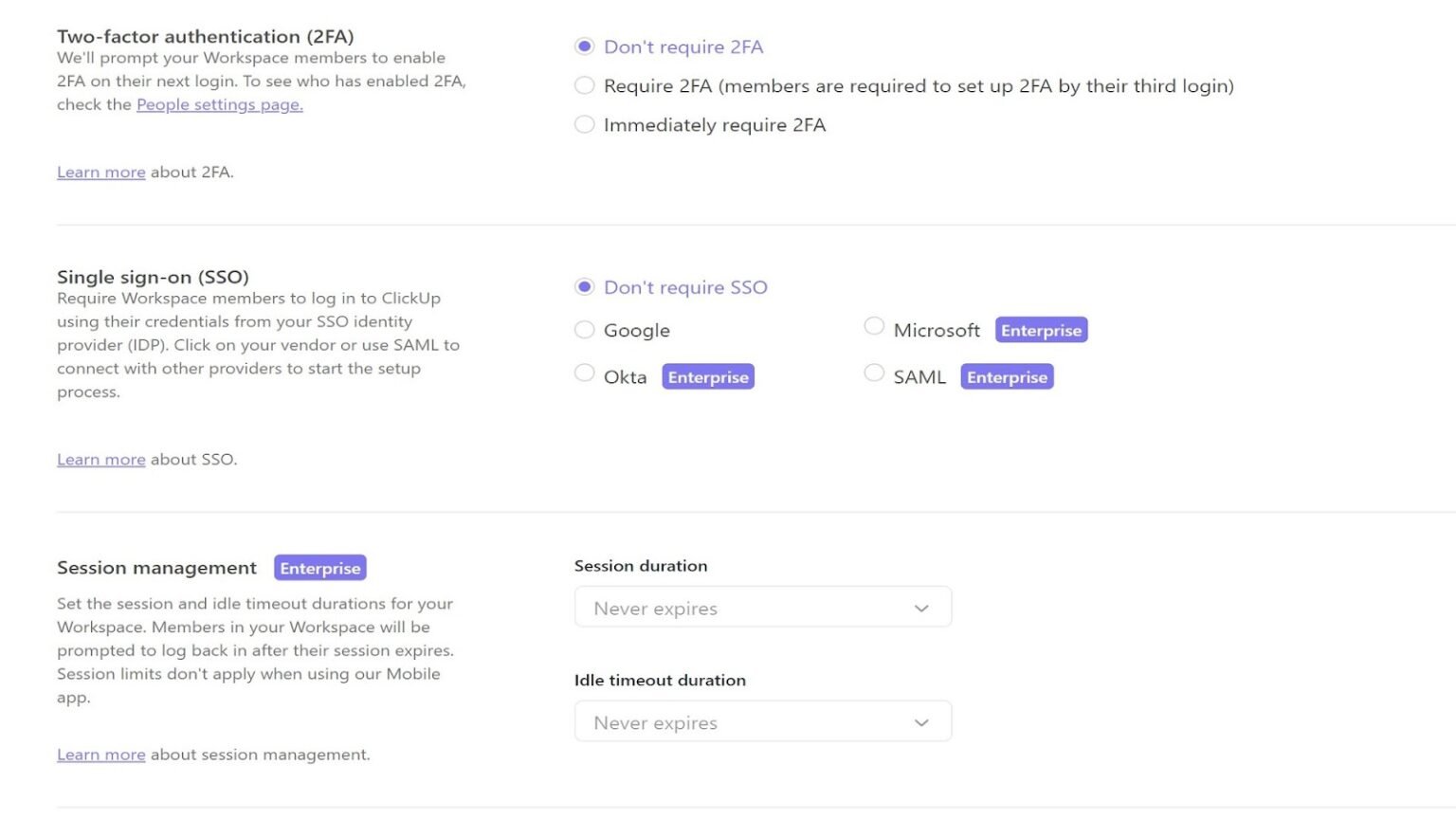
Setup and Onboarding
Connecteam offers a smooth onboarding experience with personalized support, especially on paid plans. Setup is straightforward and typically takes less than an hour to get core features up and running. The process includes guided tutorials, a dedicated success manager for Enterprise clients, and responsive customer service to assist with any questions. This hands-on support helps teams go live quickly and ensures proper configuration from the start.
ClickUp offers live onboarding training, but it’s primarily available to Enterprise customers. While there’s a solid library of tutorials, webinars, and community resources for all users, personalized onboarding support is limited on lower-tier plans.
When we tested the platform, setup was challenging because configuring dashboards and customizing workflows required a lot of manual effort. Without guided assistance, it took time to understand how everything fit together. For smaller teams or those new to project management tools, this self-guided setup could slow down adoption and make the learning curve feel steeper.
Support and Customer Service
| Support Type | Connecteam | ClickUp |
| 24/7 Chat | ✅ Available across all plans | ✅Available across all plans via an AI chatbot |
| Phone Support | ❌ | ❌ |
| Email Support | ✅ Provides on both free and paid tiers | ✅The chatbot can be used to create an email ticket |
| Help Center & Docs | ✅ Extensive and well-organized | ✅Comprehensive help center and ClickUp University learning platform |
| Live Onboarding Help | ✅ Available with certified partners or Pro plans | ✅Live onboarding offered for Enterprise customers |
| Dedicated Account Manager | ✅ Provided on paid support tiers | ❌ |
Support is where Connecteam sets itself apart. Beyond 24/7 chat, Connecteam offers a “Pros” service—an expert-led, hourly support option designed to help businesses get the most out of the platform. This service includes onboarding assistance, setup guidance, and ongoing support. I think it’s especially helpful for tailoring the platform to specific operational needs and ensuring a smooth rollout. For businesses looking for hands-on help without committing to a higher-tier plan, this flexible, pay-as-you-go model can be a smart investment.
ClickUp also offers helpful 24/7 live chat and extensive online resources, but I think Connecteam’s personalized approach leads to faster resolutions and a smoother experience, especially for businesses new to workforce management software.
🏆 Who Wins: Connecteam or ClickUp?
| Choose Connecteam if you… | Choose ClickUp if you… |
| Want an all-in-one platform for managing deskless or field-based teams. | Collaborate heavily on documents, whiteboards, and task comments. |
| Require comprehensive employee scheduling and shift management tools. | Want customizable task views and workload reporting. |
| Learn more about Connecteam | Read our in-depth ClickUp review |
Our take:
If your priority is advanced project and task management with customizable workflows, dashboards, and collaboration tools, ClickUp may be the better fit. It’s especially strong for teams managing complex projects and cross-functional work, offering flexibility and depth across planning, communication, and execution. However, some operational features (like scheduling and compliance) may require additional setup or third-party tools, particularly for non-desk-based or hourly teams..
Connecteam, on the other hand, is purpose-built for managing field and deskless teams. I think its all-in-one approach is especially effective for businesses that need to coordinate hourly or shift-based workforces. Plus, it’s very affordable.
Ultimately, the right choice depends on your team’s structure and priorities. For project-heavy environments, ClickUp offers powerful tools to manage complexity. For operationally focused teams looking for simplicity, control, and strong support, I find that Connecteam stands out as a comprehensive workforce management solution.
FAQs
Is ClickUp actually free?
Yes, ClickUp offers a free plan with basic task management, limited integrations, and built-in time tracking. However, advanced features like dashboards, workload management, and granular permissions require paid upgrades.
How secure is Connecteam?
Connecteam uses advanced security features, including two-factor authentication, single sign-on, biometric app lock, and data encryption to protect your business data. Higher-tier plans also include increased API limits and webhook management for added control.
What are the disadvantages of ClickUp?
While ClickUp excels at project and task management, its time tracking feels clunky and lacks payroll or accounting integrations. It also doesn’t support true employee shift scheduling, so teams may need extra tools for daily workforce management.
Does ClickUp integrate with Outlook?
Yes, ClickUp integrates with Outlook, allowing you to turn emails into tasks or sync calendars to keep projects and meetings aligned.

